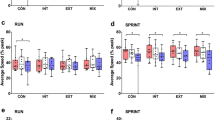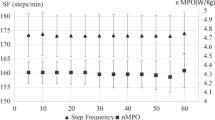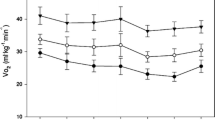Abstract
Deep body temperature (T c), pacing strategy and fluid balance were investigated during a 21-km road race in a warm and humid environment. Thirty-one males (age 25.3 ± 3.2 years; maximal oxygen uptake 59.1 ± 4.2 ml kg−1 min−1) volunteered for this study. Continuous T c responses were obtained in 25 runners. Research stations at approximately 3-km intervals permitted accurate assessment of split times and fluid intake. Environmental conditions averaged 26.4°C dry bulb temperature and 81% relative humidity. Peak T c was 39.8 ± 0.5 (38.5–40.7) °C with 24 runners achieving T c > 39.0°C, 17 runners ≥39.5°C, and 10 runners ≥40.0°C. In 12 runners attaining peak T c ≥ 39.8°C, running speed did not differ significantly when T c was below or above this threshold (208 ± 15 cf. 205 ± 24 m min−1; P = 0.532). Running velocity was the main significant predictor variable of ∆T c at 21 km (R 2 = 0.42, P < 0.001) and was the main discriminating variable between hyperthermic (T c ≥ 39.8°C) and normothermic runners (T c < 39.8°C) up to 11.8 km. A reverse J-shaped pacing profile characterised by a marked reduction in running speed after 6.9 km and evidence of an end-spurt in 16 runners was observed. Variables relating to fluid balance were not associated with any T c parameters or pacing. We conclude that hyperthermia, defined by a deep body temperature greater than 39.5°C, is common in trained individuals undertaking outdoor distance running in environmental heat, without evidence of fatigue or heat illness.



Similar content being viewed by others
References
Abbiss CR, Laursen PB (2008) Describing and understanding pacing strategies during athletic competition. Sports Med 38:252–293
Armstrong LE, Maresh CM, Gabaree CV, Hoffman JR, Kavouras SA, Kenefick RW, Castellani JW, Ahlquist LE (1997) Thermal and circulatory responses during exercise: effects of hypohydration, dehydration, and water intake. J Appl Physiol 82:2028–2035
Bland JM, Altman DG (1986) Statistical methods for assessing agreement between two methods of clinical measurement. Lancet 1:307–310
Burke LM, Wood C, Pyne DB, Telford RD, Saunders PU (2005) Effect of carbohydrate intake on half-marathon performance of well-trained runners. Int J Sport Nutr Exerc Metab 15:573–589
Byrne C, Lim CL (2007) The ingestible telemetric body core temperature sensor: a review of validity and exercise applications. Br J Sports Med 41:126–133. doi:10.1136/bjsm.2006.026344
Byrne C, Lee JKW, Chew SAN, Lim CL, Tan EYM (2006) Continuous thermoregulatory responses to mass-participation distance running in heat. Med Sci Sports Exerc 38:803–810. doi:10.1249/01.mss.0000218134.74238.6a
Casa DJ, Armstrong LE, Hillman SK, Montain SJ, Reiff RV, Rich BSE, Roberts WO, Stone JA (2000) National Athletic Trainers’ Association position statement: fluid replacement for athletes. J Athl Train 35:212–224
Cheuvront SN, Haymes EM (2001) Ad libitum fluid intakes and thermoregulatory responses of female distance runners in three environments. J Sports Sci 19:845–854
Costill DL, Kammer WF, Fisher A (1970) Fluid ingestion during distance running. Arch Environ Health 21:520–525
DuBois D, DuBois EF (1916) A formula to estimate the approximate surface area if height and weight be known. Arch Intern Med 17:863–871
Dugas JP, Oosthuizen U, Tucker R, Noakes TD (2009) Rates of fluid ingestion alter pacing but not thermoregulatory responses during prolonged exercise in hot and humid conditions with appropriate convective cooling. Eur J Appl Physiol 105:69–80. doi:10.1007/s00421-008-0876-6
Ely BR, Ely MR, Cheuvront SN, Kenefick RW, DeGroot DW, Montain SJ (2009) Evidence against a 40°C core temperature threshold for fatigue in humans. J Appl Physiol 107:1519–1525. doi:10.1152/japplphysiol.00577.2009
Eston R, Hawes M, Martin A, Reilly T (2009) Human body composition. In: Eston R, Reilly T (eds) Kinanthropometry and exercise physiology laboratory manual: tests, procedures and data, vol 1: anthropometry. Routledge, London, pp 3–53
Gagge AP, Gonzalez RR (1996) Mechanisms of heat exchange: biophysics and physiology. In: Fregly MJ, Blatteis CM (eds) Handbook of physiology: environmental physiology. American Physiological Society, Bethesda, pp 45–84
Galloway SD, Maughan RJ (1997) Effects of ambient temperature on the capacity to perform prolonged cycle exercise in man. Med Sci Sports Exerc 29:1240–1249
Gonzalez-Alonso J, Teller C, Andersen SL, Jensen FB, Hyldig T, Nielsen B (1999) Influence of body temperature on the development of fatigue during prolonged exercise in the heat. J Appl Physiol 86:1032–1039
Hausswirth CY, Le Meur Y, Couturier A, Bernard T, Brisswalter J (2009) Accuracy and repeatability of the Polar® RS800sd to evaluate stride rate and running speed. Int J Sports Med 30:354–359. doi:10.1055/s-0028-1105936
Havenith G, Coenen JML, Kistemaker L, Kenney WL (1998) Relevance of individual characteristics for human heat stress response is dependent on exercise intensity and climate type. Eur J Appl Physiol 77:231–241. doi:10.1007/s004210050327
Hayward JS, Eckerson JD, Dawson BT (1986) Effect of mesomorphy on hyperthermia during exercise in a warm, humid environment. Am J Phys Anthropol 70:11–17. doi:10.1002/ajpa.1330700104
Hew-Butler T, Verbalis JG, Noakes TD (2006) International Marathon Medical Directors Association Updated fluid recommendation: position statement from the International Marathon Medical Directors Association (IMMDA). Clin J Sport Med 16:283–292
King RF, Cooke C, Carroll S, O’Hara J (2008) Estimating changes in hydration status from changes in body mass: considerations regarding metabolic water and glycogen storage. J Sports Sci 26:1361–1363
Margaria R, Cerretelli P, Aghemo P, Sassi G (1963) Energy cost of running. J Appl Physiol 18:367–370
Marino FE (2004) Anticipatory regulation and avoidance of catastrophe during exercise-induced hyperthermia. Comp Biochem Physiol B Biochem Mol Biol 139:561–569. doi:10.1016/j.cbpc.2004.09.010
Maron MB, Wagner JA, Horvarth SM (1977) Thermoregulatory responses during competitive marathon running. J Appl Physiol 42:909–914
Martin AD, Spenst LF, Drinkwater DT, Clarys JP (1990) Anthropometric estimation of muscle mass in men. Med Sci Sports Exerc 22:729–733
Maughan RJ, Leiper JB, Thompson J (1985) Rectal temperature after marathon running. Br J Sports Med 19:192–195
Maughan RJ, Shirreffs SM, Leiper JB (2007) Errors in the estimation of hydration status from changes in body mass. J Sports Sci 25:797–804. doi:10.1080/02640410600875143
Mitchell JW, Nadel ER, Stolwijk JA (1972) Respiratory weight losses during exercise. J Appl Physiol 32:474–476
Montain SJ, Coyle EF (1992) Influence of graded dehydration on hyperthermia and cardiovascular drift during exercise. J Appl Physiol 73:1340–1350
Noakes TD (2002) IMMDA advisory statement of guidelines for fluid replacement during marathon running. New Stud Athl 17:15–24
Noakes TD, Myburgh KH, Du Plessis J, Lang L, Lambert M, Van Der Riet C, Schall R (1991) Metabolic rate, not percent dehydration, predicts rectal temperature in marathon runners. Med Sci Sports Exerc 23:443–449
Nybo L, Nielsen B (2001) Hyperthermia and central fatigue during prolonged exercise in humans. J Appl Physiol 91:1055–1060
Parsons K (2003) Measurement methods and assessment techniques. In: Human thermal environments: the effect of hot, moderate and cold environments on human health, comfort and performance. Taylor and Francis, London, pp 93–130
Passe D, Horn M, Stofan J, Horswill C, Murray R (2007) Voluntary dehydration in runners despite favorable conditions for fluid intake. Int J Sport Nutr Exerc Metab 17:284–295
Pugh LG (1970) Oxygen intake in track and treadmill running with observations on the effect of air resistance. J Physiol 207:823–835
Pugh LG, Corbett JL, Johnson RH (1967) Rectal temperatures, weight losses, and sweat rates in marathon running. J Appl Physiol 23:347–352
Robinson S (1963) Temperature regulation in exercise. Pediatrics 2:691–702
Rothstein A, Adolph EF, Wills JH (1947) Voluntary dehydration. In: Adolph EF, and Associates (eds) Physiology of man in the desert. Interscience, New York, pp 254–270
Sawka MN, Burke LM, Eichner ER, Maughan RJ, Stachenfeld NS (2007) American College of Sports Medicine position stand. Exercise and fluid replacement. Med Sci Sports Exerc 39:377–390. doi:10.1249/mss.0b013e31802ca597
Selley EA, Kolbe T, Van Zyl CG, Noakes TD, Lambert MI (1995) Running intensity as determined by heart rate is the same in fast and slow runners in both the 10- and 21-km races. J Sports Sci 13:405–410
Tatterson AJ, Hahn AG, Martin DT, Febbraio MA (2000) Effects of heat stress on physiological responses and exercise performance in elite cyclists. J Sci Med Sport 3:186–193. doi:10.1016/S1440-2440(00)80080-8
Townshend AD, Worringham CJ, Stewart IB (2010) Spontaneous pacing during overground hill running. Med Sci Sports Exerc 42:160–169
Tucker R, Noakes TD (2009) The physiological regulation of pacing strategy during exercise: a critical review. Br J Sports Med 43:e1. doi:10.1136/bjsm.2009.057562
Tucker R, Rauch L, Harley YX, Noakes TD (2004) Impaired exercise performance in the heat is associated with an anticipatory reduction in skeletal muscle recruitment. Pflugers Arch Eur J Physiol 448:422–430. doi:10.1007/s00424-004-1267-4
Tucker R, Marle T, Lambert EV, Noakes TD (2006) The rate of heat storage mediates an anticipatory reduction in exercise intensity during cycling at a fixed rating of perceived exertion. J Physiol 574:905–915. doi:10.1113/jphysiol.2005.101733
Wilk B, Bar-Or O (1996) Effect of drink flavour and NaCL on voluntary drinking and hydration in boys exercising in the heat. J Appl Physiol 80:1112–1117
Wilkinson DM, Carter JM, Richmond VL, Blacker SD, Rayson MP (2008) The effect of cool water ingestion on gastrointestinal pill temperature. Med Sci Sports Exerc 40:523–528. doi:10.1249/MSS.0b013e31815cc43e
Williams C, Nute ML (1983) Some physiological demands of a half-marathon race on recreational runners. Br J Sports Med 17:152–161. doi:10.1136/bjsm.17.3.152
Wyndham C, Strydom N (1969) The danger of an inadequate water intake during marathon running. S Afr Med J 43:893–896
Acknowledgments
The authors express their thanks to the volunteers for their participation. We also thank HQ Commandos and HQ Signal (4th Singapore Armoured Brigade) of the Singapore Armed Forces for their participation and support in this research. Finally, we would like to thank Margaret Yap, Teo Ya Shi, Sharon Sng, Chia Ee Von, Jacinta Yeo, David Fan, Priscilla Fan, Grace Teo, Caleb Gan, Joselin Lim, Soh Boon Kee, Evania Tan, Lydia Law, Ian Ng and the student volunteers from ITE College East for their role in data collection. We are grateful to Dr Raija Laukkanen at Polar Electro Oy, Kempele, Finland, for donating the Polar RS800sd running computer. Dr Chris Byrne was supported by an international outgoing short visit grant from the Royal Society, UK.
Author information
Authors and Affiliations
Corresponding authors
Additional information
Communicated by Narihiko Kondo.
Rights and permissions
About this article
Cite this article
Lee, J.K.W., Nio, A.Q.X., Lim, C.L. et al. Thermoregulation, pacing and fluid balance during mass participation distance running in a warm and humid environment. Eur J Appl Physiol 109, 887–898 (2010). https://doi.org/10.1007/s00421-010-1405-y
Accepted:
Published:
Issue Date:
DOI: https://doi.org/10.1007/s00421-010-1405-y




